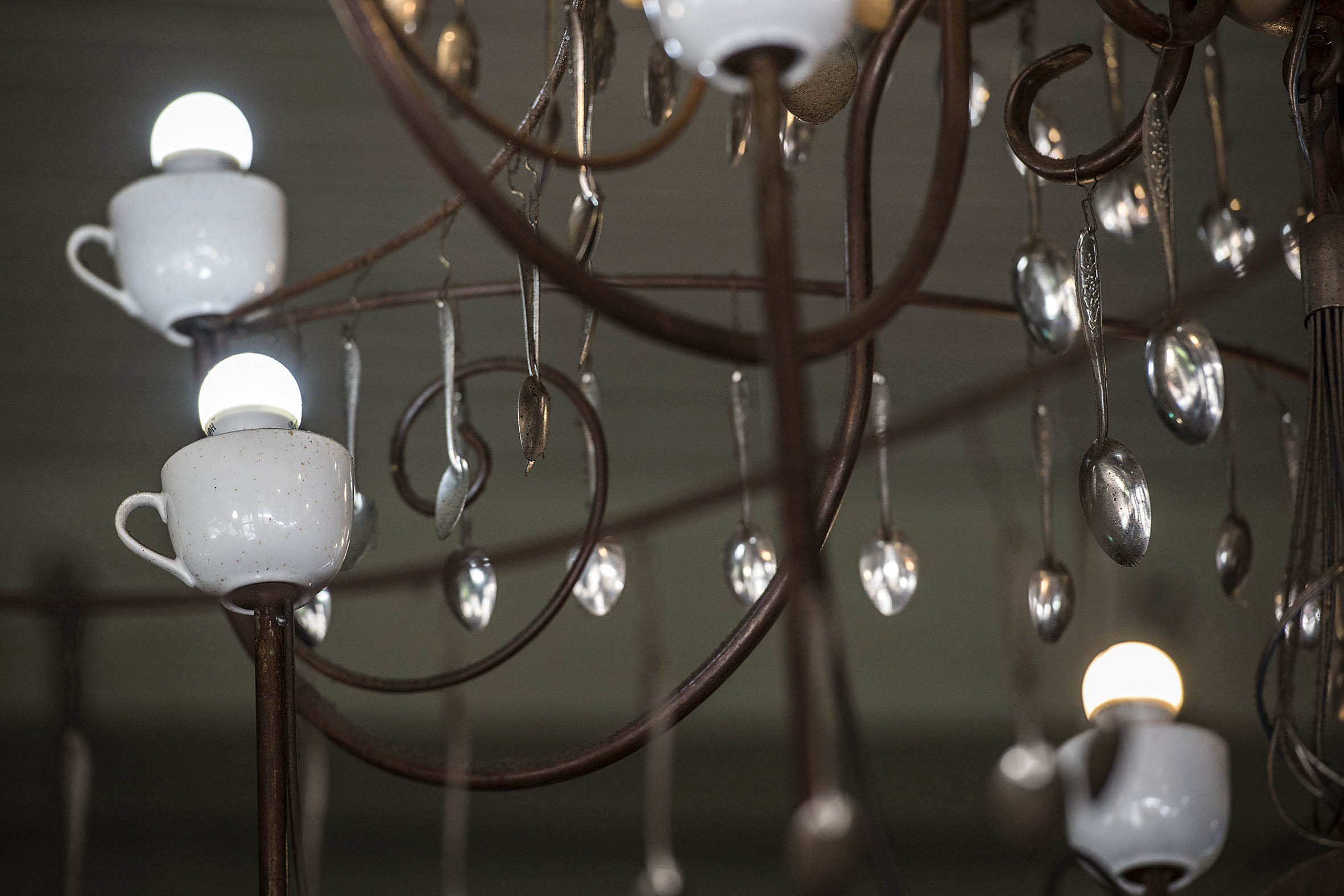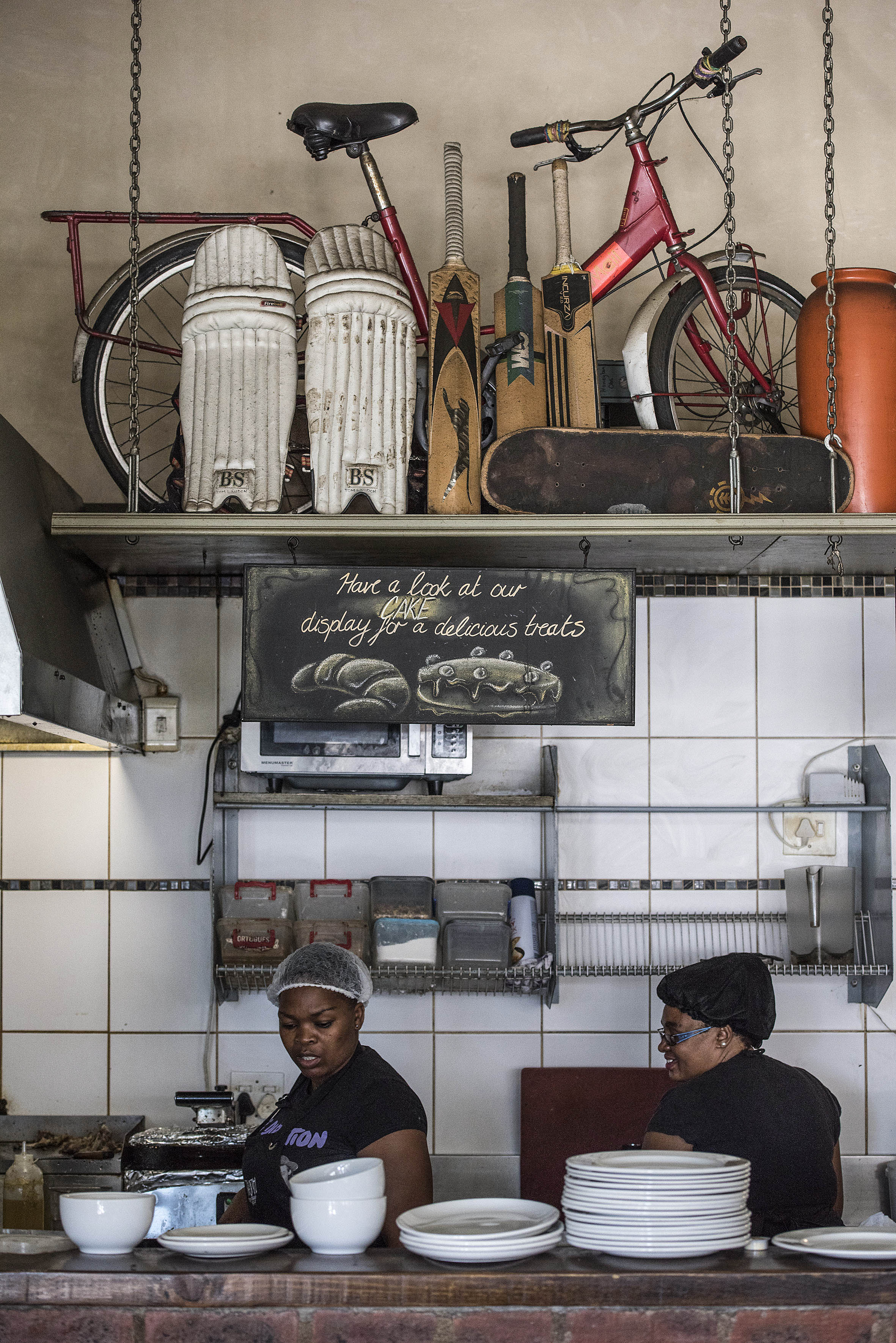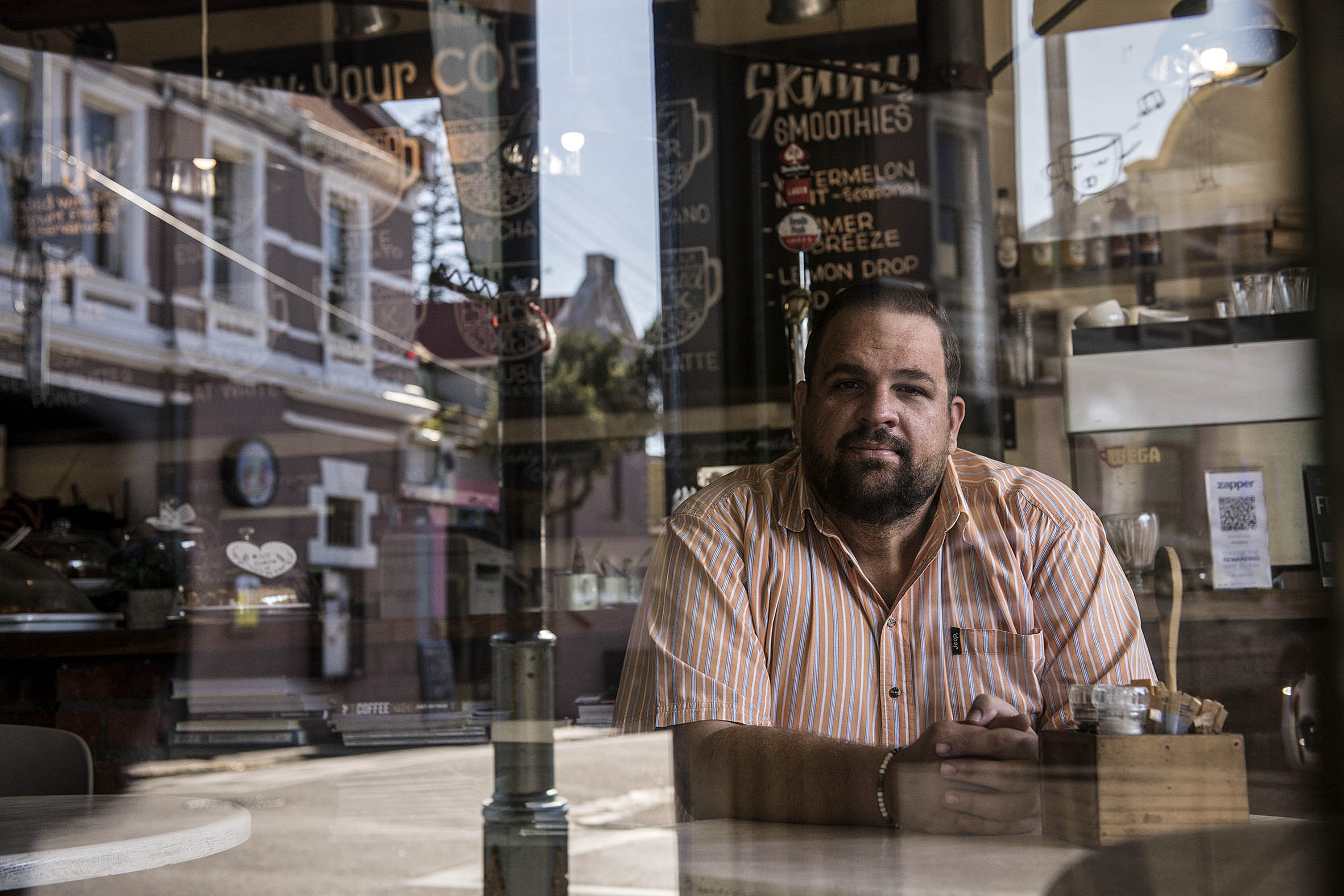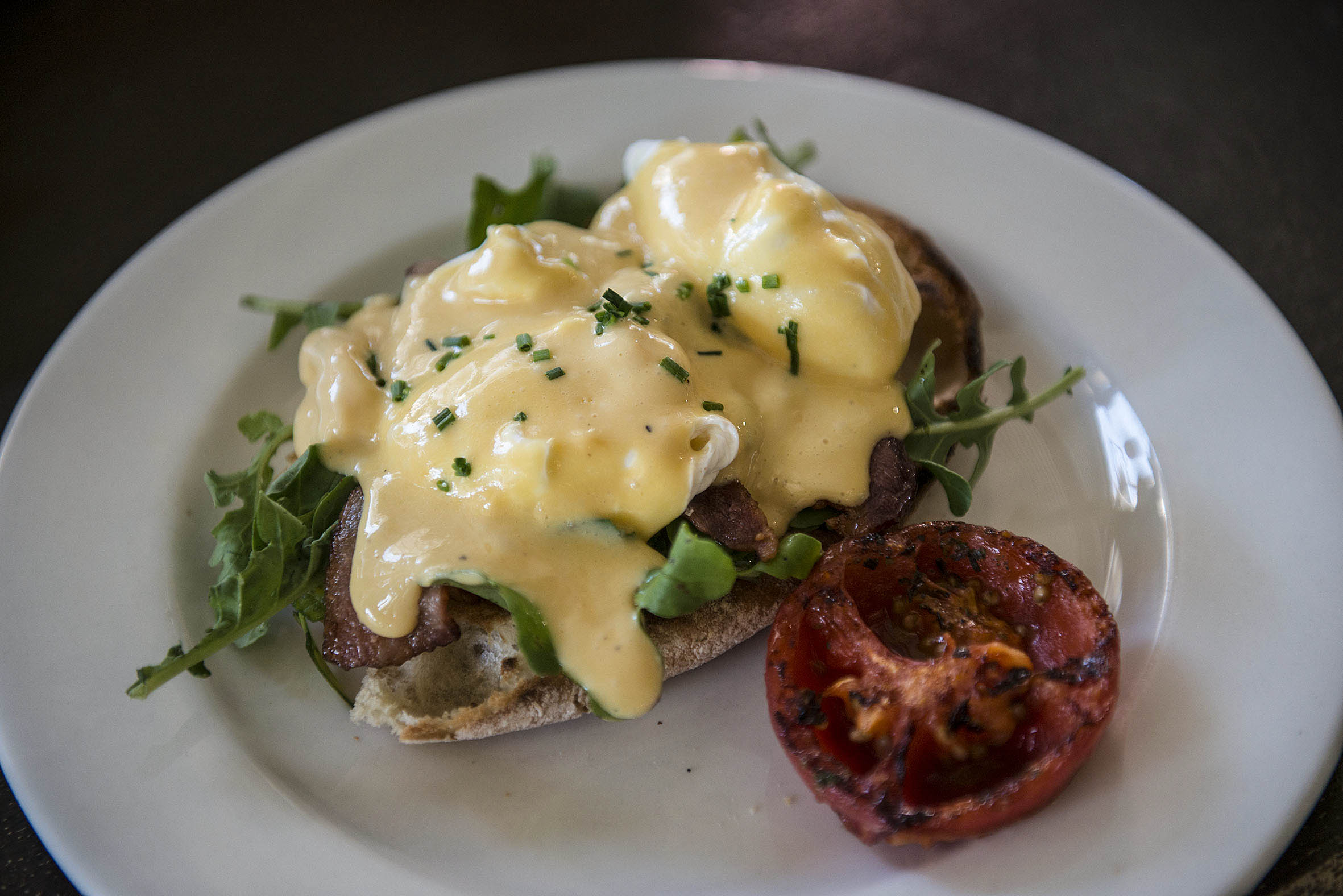Endearing aesthetic: The décor is intentionally vintage with items such as coins and bills. Photos: David Harrison
Situated on the corner of Lower Main and Trill roads in Observatory, Cape Town, the Honeybun coffee shop looks on to a duvet of clouds that hang over Table Mountain on an overcast Saturday morning.
It’s just after 9am and most of the tables inside the eatery have been occupied. “They’ve just paid their bill,” smiles a middle-aged woman with a stained black apron. “You can sommer just wait outside and I’ll call you as soon as they leave.”
Apart from the dining furniture, the inside is a cosy blend of old and new. Almost every countertop is populated with antiquated kitsch: cookie jars, coffee-stained books, sacks of flour, cake stands and pyramids of old soup cans. They are accompanied by an outdated fridge covered in postcards, old photographs, pennies and a £1 note.
A large chalkboard hangs on a wall behind the counter where our hosts write up bills and prepare aromatic coffee blends. Chalk drawings of mugs explain what goes into the various offerings. From an espresso to a latte macchiato, the “ingredient diagrams” simplify the ordering process by removing the need to ask which coffee contains what.
A brick counter, piled with stacks of bowls and plates, separates our table from the eatery’s open-plan kitchen, which allows us a peek into the food preparation area.
Above our table is Honeybun’s centrepiece: an elaborate chandelier made from kitchen accessories, including teaspoons, salad bowls and fine china pieces. All other light fixtures appear to be strainers and ice buckets. In one corner, a flat-screen TV is mounted on the wall and the staff flick between news channels.
Though a description of Honeybun’s interior may read as cluttered or cramped, it all makes for the endearing aesthetics, smells and acoustics that resemble a visit to a loved one rather than a restaurant.

Endearing aesthetic: The décor is intentionally vintage with items such as a cutlery and crockery chandelier (above) and items reminiscent of distant childhood bedrooms (below). Photo: David Harrison

Watching over the preparation of our food with the sound of crockery clinking and clanking in a nearby sink, while a news anchor lists the hour’s headlines, makes one feel right at home.
Indeed, according to its management, Honeybun’s menu and ambience come from them wanting patrons to feel at home.
“We try to make the experience homey, safe and happy so that they [customers] will come back,” says Christo Hattingh, operations manager for Honeybun, the Wiesenhof Coffee Franchise and Fat Harry’s in the Western Cape.

At home: Honeybun’s Christo Hattingh defends the‘make-yourself-at-home’ vibe at Cape Town’s Honeybun. Photo: David Harrison
He says the move to open the coffee shop had to do with the gap that emerged when Observatory was “going through remodelling”.
The space seems to capitalise on the need for a home-away-from -home space for those who feel displaced in the city. One such person is master’s student Oboitshepo Tladi.
“My partner and I decided that every weekend we’re going to take a 40-minute walk to discover new places around Cape Town. That’s how I discovered Honeybun. I love it because it’s cosy and feels like home. The waiters give off a strong tannie [aunty] vibe, plus we get to observe the buzz of Observatory as if we are not there.”
On handing us our clipboard menus, our waiter notices a cough at the table. She takes the orders and insists on adding a ginger shot. “Ag shame, if that doesn’t work by the time you leave, I’ll give you my home remedy,” she says with a sincerely concerned smile.
Our party of three had the usual bacon, toast, tomato and egg combo with sides of mushrooms, salmon and avocado, but Honeybun also offers other homey options such as muesli, chia parfait, croissants, sandwiches and soup.
The flavour combinations are safe in that they are familiar. Instead of offering complex or layered tastes, their recipes act as a solid foundation that patrons are welcome to embellish with items from the add-on menu.

Honeybun, where traditional breakfasts are satisfying, if uncomplicated. Photo: David Harrison
Unfortunately, the “make-yourself-at-home” principle seems to be taken a step too far where service is concerned. After our orders were taken, very little attention was given to us and it was only after a few “excuse me” attempts that our waiter returned to our table.
Instead of being told that water was on a self-service basis, we were instructed to pour our own in a tone that suggested we should know better. And it was only upon enquiring whether they remembered an order for a cappuccino that they explained why it was late.
The reviews on Honeybun’s Facebook page seem to echo this: customers complain about the long waiting periods after being seated and a seemingly nonchalant attitude from staff. Perhaps the service has to do with the front-of-house staff to customer ratio.
“The front-of-house staff is shift dependent,” says Hattingh. “We have two to three on a busy day and one is enough when foot traffic is slow.” When asked whether he thinks this is really enough, the operations manager responds that Honeybun’s staff are well trained.
In spite of the service mishaps, Honeybun cannot be faulted for the homely vibe that continues to attract the patrons and keeps its doors open.
Honeybun’s formula also taps into the current trend towards the homestyle dining experience.
Private chef Ayabonga Gobe, who has been in the industry for nine years, sees the move as the restaurant industry’s response to the emerging use of chefs in people’s homes.
“My clients are no longer as interested in the fine-dining experience; they want homey food at home. Perhaps restaurants are doing this because they need to keep up, so they don’t lose out,” Gobe suggests.
Amanda Mkhonza (30), an environmental lawyer at the University of Cape Town, attests to Gobe’s sentiment. Last year, Mkhonza made use of a private chef for her birthday celebration, because restaurant options worked out to be more expensive for her party of 20.
“Not only the food, but also the corkage and other drinks on the side,” she says. A private chef remained within the confines of her R5 000 budget and allowed her guests to have free reign in choosing their meals instead of being forced to choose from set menus.
“The personalisation is what made it absolutely amazing. But there’s also a luxury that comes with being in your home, having a chef in your space, not being rushed, and being able to have a good time without being considerate of the people at the next table,” Mkhonza adds.
Lifestyle journalist and founder of The Scullery blog, Inga Sibiya, who reviews Southern African restaurants, admits that the home-dining experience is growing.
“It’s definitely an emerging trend. But that’s the thing: food trends are constantly evolving. Restaurateurs are always looking to create the most innovative, most creative experience; that way they can keep the doors open. But I don’t understand why people wouldn’t just eat at home if that’s the experience they want,” says Sibiya.
Hiring a private chef is a luxury way beyond the reach of most South Africans, however. For this reason, establishments like Honeybun are a welcome haven for those seeking the touches of home while out and about.